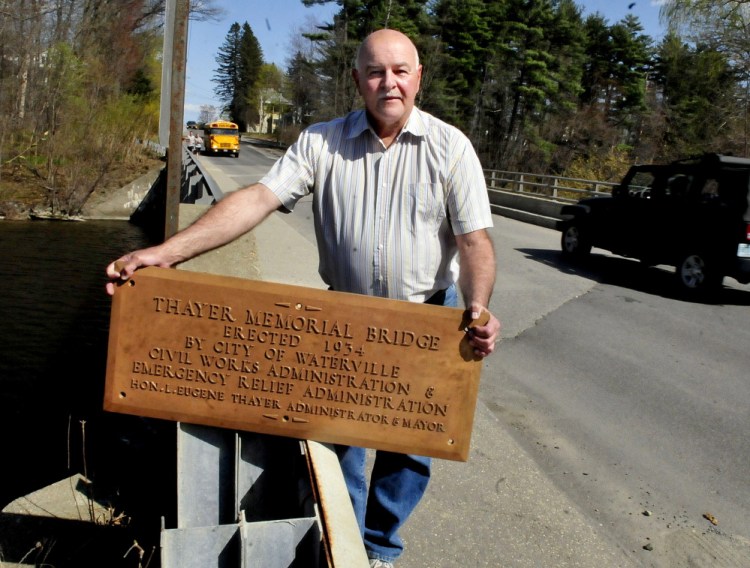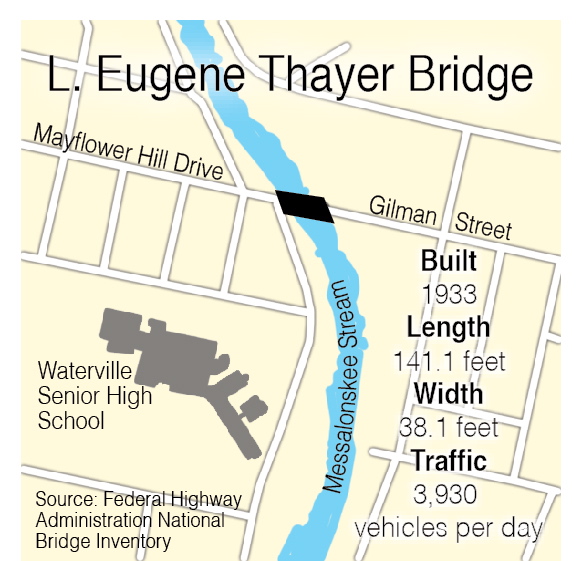WATERVILLE — City officials are trying to solve a mystery involving a long-dead mayor, a bridge and a bronze plaque that disappeared many years ago from that bridge but recently was discovered in the basement of a building.
The investigation into the mystery started several weeks ago when a man in a pickup truck drove into the Public Works Department complex on Wentworth Court with the 50-pound plaque, saying it was found in a house that was being razed. He did not leave his name or a location where the plaque was found, according to Public Works Director Mark Turner.
“Some guy just dropped it off,” Turner said. “They were tearing down a building, and he found it in the basement and thought he should return it to the city of Waterville.”
The 2-by-3-foot plaque reads, “Thayer Memorial Bridge, Erected 1934 by City of Waterville Civil Works Administration and Emergency Relief Administration, Hon. L. Eugene Thayer, administrator and mayor.”
It refers to former Waterville Mayor Lorenzo Eugene Thayer, who died Sept. 3, 1934, at 51 and is the only city mayor to have died while in office.
Not knowing what bridge the plaque belonged to, Turner, public works Operations Manager Bob Gilchrist and City Engineer Greg Brown started scouting around, looking at bridges and doing research on the Internet.
Turner took a walk down Gilman Street one day and discovered an indentation on the Gilman Street bridge that exactly fit the shape and size of the plaque, which was oxidized and stained from being in a moist environment. Public Works mechanic Cary Collamore took the plaque home to his shop and on his own time cleaned it up using a mild solvent and then air blasted it with fine silica particles to remove surface buildup and stains, Turner said. Then he applied a sealant to preserve the bronze finish.
More city officials got in on the act. City Planner Ann Beverage dug up an annual city report from 1935 that spells out the city government’s decision to rename the Gilman Street Bridge for Thayer after his death. He was a hard-working mayor who was in office during the Great Depression and was successful in re-establishing the city’s damaged credit after banks had closed, the report said.
RENAMING A BRIDGE
After Thayer’s death, city officials decided to rename the Gilman Street Bridge over Messalonskeee Stream “Thayer Memorial Bridge.”
Thayer, a Waterville native and Colby College graduate, also was one of the founders of the Morning Sentinel in 1904 and served as its business manager. He headed the local Federal Relief Administration, helping the needy and unemployed, and was affiliated with several insurance companies. He also was a director of People’s National Bank and was a member of several social and civic organizations, including the Waterville Rotary Club, according to a story in the Sentinel’s Sept. 4, 1934, edition. A Democrat, he was elected mayor in 1933 and re-elected in the spring of 1934 by the largest majority in the city’s history, according to the story. Thayer at various times also served as the city’s auditor, tax collector and treasurer, and was a member of the city’s Common Council.
That page one story announcing Thayer’s death says he died in the hospital after suffering a cerebral hemorrhage. He had been in the hospital nearly two months and had been admitted to receive treatment for Bright’s Disease, according to the story. Bright’s is a condition involving the kidneys.
Mourners packed the Unitarian Church for Thayer’s funeral, held Sept. 5, 1934, with hundreds of people flowing out onto the street, according to the Sentinel’s Sept. 6, 1934, edition. Colby College’s dean, Ernest C. Marriner, delivered the eulogy, saying Thayer was a “private citizen in public service” and a “Christian gentleman in politics.”
“He inspired faith and confidence in those with whom he dealt that the city of Waterville would, given time, pull through this depression with a clean slate and would meet all its obligations,” Marriner said. “In administering the general affairs of the city, he was faithful and efficient.”
FATE OF A PLAQUE
Turner surmises the bridge plaque was stolen many years ago. He said he has been in the area since the 1960s and does not recall seeing the plaque on the Gilman Street Bridge.
Waterville police Chief Joseph Massey also did some digging to try to help solve the mystery, calling police officers and detectives who worked in the city during the ’60s and ’70s. While they vaguely recalled a plaque being stolen from that bridge, they could not be sure, according to Massey.
The police department does not have records that would confirm the plaque was stolen.
“I think anything later than the ’80s for us is probably not even retrievable,” Massey said.
Earl Smith, an author, historian and retired Colby dean who wrote “Mayflower Hill: A History of Colby College,” said by 1931 Colby officials had decided to move the college from what is now Colby Circle off Front Street and College Avenue to Mayflower Hill, which then was home to seven farms.
During that time, Gilman Street, which led to the farmland, was widened and the bridge erected — later to be called Gilman Street Bridge.
Willard B. Arnold III, past president of the Waterville Historical Society, said he did not recall anything about a plaque having been stolen from the bridge, but Arnold, who spent six years indexing stories at the Morning Sentinel, was able to identify the newspaper issues containing stories about Thayer, making them more easy to find on microfilm at Colby.
Coincidentally, about a week before the unidentified man brought the plaque to public works, a relative of Thayer stopped at City Hall and spoke with Amanda Esler, City Manager Michael Roy and Mayor Nick Isgro’s executive assistant.
Esler said she walked out of her office one day and saw a man standing and looking up at the portrait of Thayer on the wall. As the plaque had not yet surfaced, Esler had no reason to ask for the man’s name.
“He said, ‘I’m just looking at my great-uncle,'” Esler recalled this week. “He said, ‘You know, I still remember when he died. We were at the family camp in Belgrade. I was 5 years old and we got a phone call. There was stunned silence.’ He said his great-uncle was the only Waterville mayor to die during his term, and he was a founder of the Morning Sentinel.”
Esler said the man told her a happy day at the camp turned somber when the family learned “Genie” had died.
Esler was fascinated by his story and later, when she learned of the plaque’s having been returned to the city, she wished she had spoken more with him.
“I never got his name,” she said.
Now, Turner and other city officials say they want to honor Thayer by returning the plaque to the bridge and possibly holding a re-dedication of the bridge in September on the 80th anniversary of when the bridge was renamed for the former mayor.
“It’s almost like something — or the powers that be — somehow got that plaque back to us,” Turner said. “I don’t know how. It’s almost like his heritage came back to life.”
City Council Chairman Fred Stubbert, D-Ward 1, said the plaque should be returned to the bridge, its rightful home.
“We’re going to put it back on the bridge. That’s the current plan,” he said. “We’re hoping we can find some of Thayer’s relatives.”
Thayer was married to Florence Thayer and was the son of Nora P. and Frank L. Thayer. He and Florence had two daughters, Mary E. and Ann P. Thayer.
Amy Calder — 861-9247
Twitter: @AmyCalder17
Send questions/comments to the editors.





Comments are no longer available on this story